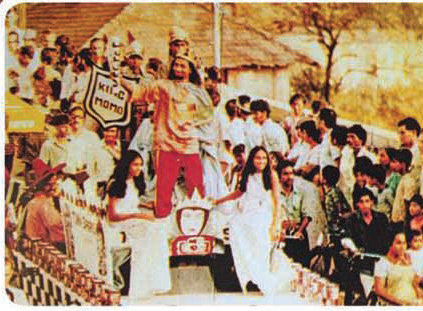24 Mar 2017 | 08:43pm IST
The eternal king of the parade
While Carnival and Shigmo are known for their grandeur today, it was a simple man’s dream to bring these festivals to the city that got the ball rolling. That man, Timoteo Fernandes, was the first King Momo of the Carnival Parade in Panjim and he is still an active member of the Carnival and Shigmo committees in Panjim. At the age of 80, he is still full of energy and brimming with stories of yore. Café catches up with the culture veteran
How many festive parades have you witnessed
in Goa? Which was the grandest float you’ve seen?
Which mythological story was best depicted during
the Shigmo parade four years ago? While you may
love these eye-catching festivals of Goa, answering
such explicit questions may not be possible for you.
But Timoteo Fernandes from Panjim still remembers
what he dressed up as and how he prepared for the
carnival parades of the 1950s. Amazingly, he also
remembers how much it cost him to decorate his
Timoteo was recently felicitated by the Carnival
Committee as well as the Panaji Shigmo Samita for
his 50 years of contribution to the committees. The
80-year-old is showing no signs of slowing down
as he is as active as the youngest member of the
committee, if not more. “I am very happy to be a
member of both the committees. My suggestions
are taken into consideration and acted upon and all
the members respect me,” says Timoteo, who was
awarded the State Culture Award in 1981.
Timoteo Fernandes was the first King Momo for
the Carnival Parade in Panjim in 1967. However,
before that he had already held two carnival
celebrations on his own. Going back in time,
Timoteo explains how carnival was celebrated
during his childhood. “In the 1950s, Carnival was a
big festival as it was a celebration of three days and
people looked forward to it. There was a division of
the people. The high class or aristocratic families
celebrated carnival in Panjim at Clube Vasco da
Gama and Clube Nacional and in Margao at Clube
Harmonia or BPS Sports Club with night long
celebrations of music, song and dance. The others
set up a ‘matto’ like an open air pandal or used
the large halls of one of the houses and organised
dances for the three days,” he reminisces.
“The villages in Salcete had their very own
celebrations. They used to have ‘fell’ where a group
of young boys and men performed skits or songs
based on historical events. In Panjim, there were
two hotels – Hotel Joao just above Godinho Bar
and Restaurant, and one close to Café Bhosle – that
had employees who were originally from Salcete.
During Carnival, they would come together and
form their own group for ‘fell’ in Panjim. They would
visit the house of the ‘Regidor’ and sing two songs
before performing at different places throughout
the night. As kids, we were excited to follow them to
see what they sang and what comedy skits they put
up. During the day, we would dress up and throw
‘cocad’, a small pack of powder, at passers-by. I
used to dress up as an African woman and sell fruits.
It was a different era,” adds Timoteo, son of late
Arcenio and late Maria Jose Fernandes.
In 1965, Timoteo introduced the spirit of King
Momo to Panjim. “I visited the home of Vasco
Alvares, President of Clube Nacional, and found
magazines of the carnival
celebrations at Rio De Janeiro,
Brazil. I met an owner of a
bullock cart from Merces,
rented his cart and decorated
it at Patto Bridge, Panjim. The
cart cost me Rs 5 while the
entire decoration cost me just
one rupee. I stood in front,
dressed as King Momo, and
asked my friends to come along
with me, singing and dancing
till Municipal Garden. The bull
got a bit agitated with all the
calmed it down and we reached
the garden safely,” explains
Timoteo. This was the first
carnival ‘parade’, held three
After two carnivals, the Carnival committee
was established and again Timoteo was the official
King Momo. As every year Carnival is immediately
followed by the celebrations of Shigmo, the Hindu
brethren wished to have their own celebrations
on a grand scale in Panjim and hence the Shigmo
Committee was established. “It was difficult to
organise the festival within a short span of time
but we visited different people to learn more about
the celebrations and how to present the parades in
Panjim. Shigmo is still very true to its folk dances
and it required particular trained performers, which
was challenging. The first carnival parade was held
from Patto Bridge to Municipality garden and the
first Shigmo Parade was from Patto Bridge to Azad
Maidan,” he says. With the increasing number of
spectators, the routes for both the parades were
Timoteo is still learning from every Carnival and
Shigmo parade that goes by. He minutely observes
them and when asked, is glad to give his advice
after years of experience in the cultural circle.

